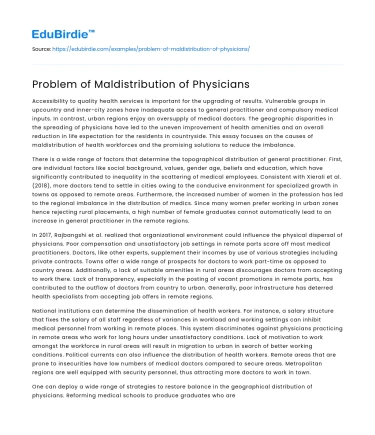Accessibility to quality health services is important for the upgrading of results. Vulnerable groups in upcountry and inner-city zones have inadequate access to general practitioner and compulsory medical inputs. In contrast, urban regions enjoy an oversupply of medical doctors. The geographic disparities in the spreading of physicians have led to the uneven improvement of health amenities and an overall reduction in life expectation for the residents in countryside. This essay focuses on the causes of maldistribution of health workforces and the promising solutions to reduce the imbalance.
There is a wide range of factors that determine the topographical distribution of general practitioner. First, are individual factors like social background, values, gender age, beliefs and education, which have significantly contributed to inequality in the scattering of medical employees. Consistent with Xierali et al. (2018), more doctors tend to settle in cities owing to the conducive environment for specialized growth in towns as opposed to remote areas. Furthermore, the increased number of women in the profession has led to the regional imbalance in the distribution of medics. Since many women prefer working in urban zones hence rejecting rural placements, a high number of female graduates cannot automatically lead to an increase in general practitioner in the remote regions.
Save your time!
We can take care of your essay
- Proper editing and formatting
- Free revision, title page, and bibliography
- Flexible prices and money-back guarantee
In 2017, Rajbangshi et al. realized that organizational environment could influence the physical dispersal of physicians. Poor compensation and unsatisfactory job settings in remote parts scare off most medical practitioners. Doctors, like other experts, supplement their incomes by use of various strategies including private contracts. Towns offer a wide range of prospects for doctors to work part-time as opposed to country areas. Additionally, a lack of suitable amenities in rural areas discourages doctors from accepting to work there. Lack of transparency, especially in the posting of vacant promotions in remote parts, has contributed to the outflow of doctors from country to urban. Generally, poor infrastructure has deterred health specialists from accepting job offers in remote regions.
National institutions can determine the dissemination of health workers. For instance, a salary structure that fixes the salary of all staff regardless of variances in workload and working settings can inhibit medical personnel from working in remote places. This system discriminates against physicians practicing in remote areas who work for long hours under unsatisfactory conditions. Lack of motivation to work amongst the workforce in rural areas will result in migration to urban in search of better working conditions. Political currents can also influence the distribution of health workers. Remote areas that are prone to insecurities have low numbers of medical doctors compared to secure areas. Metropolitan regions are well equipped with security personnel, thus attracting more doctors to work in town.
One can deploy a wide range of strategies to restore balance in the geographical distribution of physicians. Reforming medical schools to produce graduates who are prepared to work in remote areas is the initial step. Reforms should focus on the production of family doctors, not hospital-based doctors. Establishment of a compulsory rural internship can reduce the imbalance since medical doctors can opt to work in the rural area after the internship. Also, educational subsidies to rural staff which seeks to specialize in areas that will benefit the community can encourage more doctors to work in remote areas (Zhu et al., 2019). Therefore, adequate investment in the shaping of medical students to work in remote areas is vital.
Adopting rural recruitment and training can reduce the imbalance in the distribution of medical staff. In this strategy, recruitment of medical students necessitates that students must sign a contract that obliges them to work in a rural area after graduation for a specified duration. Moreover, students conduct their internships in the remote area where they will work once they graduate for the familiarization (Humpreys et al., 2017). Establishment of well-equipped medicinal schools, hospitals and clinics throughout a country is crucial for the success of this strategy.
In 2017, Behera et al. disclosed that motivating general practitioner in unattractive areas by offering incentives can greatly reduce the disparity in the ecological scattering of doctors. Multiple profits for instance, study and recreational leaves, allowances, developed social amenities and bonuses based on working hours. Supporting medical practitioners in remote areas to advance their studies by paying part of their fee can motivate them to work and attract more in the region. Salary increment, especially to physicians working in hardship areas, can act as bait, thus pulling more staff from urban areas to offset the imbalance. Encouraging health employees to work as private staff in various institutions to supplement their salary will reduce rural-urban migration in search of private side job.
According to Mlambo et al. (2018), decentralizing the location of health schools and other tertiary services is important in ensuring the equal distribution of physicians. Standardization of training institutions throughout a country in terms of infrastructure, staff and quality of education is important. The institutions should equally embrace new educational tools such as the use of videoconference, which can also be used in rural areas for training and as a treatment tool. Security personnel must be deployed to remote areas to assure safety to the staff. Generally, development must be decentralized to encourage the balanced distribution of medical workers.
In conclusion, gender disparity can cause immense inequities in the dispersal of physicians since females tend to avoid working in countryside. Low salary and poor working conditions discourage physicians to accept jobs in isolated areas. Enthusiasm to work is thus key in the rural health sector. Incentives and proper working conditions are elementary motivators to physicians in rural areas. Moreover, a good salary can attract and retail workers in remote areas, thus correcting the unevenness in the spreading of the medical staff.






 Stuck on your essay?
Stuck on your essay?

